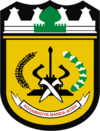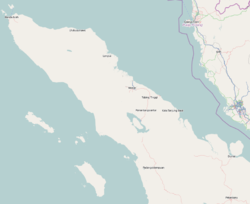Kutaraja
|
Banda Aceh
Banda Acèh Kuta Raja |
||||||||
|---|---|---|---|---|---|---|---|---|
| City | ||||||||
| Other transcription(s) | ||||||||
| • Jawi | باندا اچيه | |||||||
From top left : Baiturrahman Grand Mosque, Aceh Tsunami Museum, Seulawah 001 Monument, 2004 Indian Ocean Tsunami Monument, Gunongan Historical Park, Kerkhof Peucut
|
||||||||
|
||||||||
| Nickname(s): Kota Serambi Mekkah | ||||||||
| Motto: Saboeh Pakat Tabangun Banda | ||||||||
| Location of the city in northern Sumatra | ||||||||
| Coordinates: 5°33′0″N 95°19′0″E / 5.55000°N 95.31667°ECoordinates: 5°33′0″N 95°19′0″E / 5.55000°N 95.31667°EID | ||||||||
| Country |
|
|||||||
| Province |
|
|||||||
| Founded | 22 April 1205 | |||||||
| Government | ||||||||
| • Mayor | Illiza Sa'aduddin Djamal | |||||||
| Area | ||||||||
| • City | 61.36 km2 (23.69 sq mi) | |||||||
| • Metro | 2,935,36 km2 (113,335 sq mi) | |||||||
| Elevation | 0-10 m (0-32.9 ft) | |||||||
| Population (2016) | ||||||||
| • City | 356.983 | |||||||
| • Density | 5.8/km2 (15/sq mi) | |||||||
| • Metro | 513,698 | |||||||
| • Metro density | 1.8/km2 (4.5/sq mi) | |||||||
| Demonym(s) | Acehnese Warga Aceh (id) Kawom Aceh (ace) |
|||||||
| Demographics | ||||||||
| • Ethnic groups |
Acehnese Javanese Gayo Batak Alas Simeulue Aneuk Jamee Tamiang Malay Singkil Minangkabau |
|||||||
| • Religion |
Islam 97.09% Buddhism 1.13% Christianity 0.70% Catholic 0.19% Hinduism 0.02% Others 0.85% |
|||||||
| • Languages |
Indonesian (official) Acehnese (regional) |
|||||||
| Time zone | WIB (UTC+7) | |||||||
| Postal code | 23000 | |||||||
| Area code(s) | +62 651 | |||||||
| License plate | BL XXX XX | |||||||
| Website | www |
|||||||
Banda Aceh, formerly known as Kuta Raja, is the capital and largest city in the province of Aceh, Indonesia. It is located on the island of Sumatra and has an elevation of 35 meters. The city covers an area of 64 square kilometres and had a population of 219,070 people, according to the 2000 census. Banda Aceh is located on the northwestern tip of Indonesia at the mouth of the Aceh River.
The city was originally established as Bandar Aceh Darussalam Kandang and served as a capital and hub for the Sultanate of Aceh upon its foundation in the late 15th century. Later its name was changed to Bandar Aceh Darussalam, and then became popularly known as Banda Aceh. The first part of the name comes from the Persian bandar (بندر) meaning "port" or "haven." The city is also dubbed the "port to Mecca," or the "porch of Mecca" (Indonesian: Serambi Mekkah) in reference to the days when hajj pilgrims travelled by sea from Indonesia and would make a stop over in the city before continuing their journey to Mecca.
Banda Aceh had long been at the centre of protracted conflicts between the Acehnese and foreign domination, including war with Portuguese, wars with the Dutch, the Japanese and the Indonesian government. The city rose to international prominence in the aftermath of the Indian Ocean earthquake in 2004, which struck off the western coast of Sumatra. Banda Aceh was the closest major city to the earthquake's epicentre, which lay 249 km off the coast. It suffered great damage in the earthquake and further damage when a tsunami struck shortly afterwards. 167,000 people died as a result and many more were injured.
The aftermath of the tsunami has seen a cessation of much of the conflict in the city and province, and domestic and international aid as a result has seen a major modernisation and reconstruction of the city over the past decade.
Banda Aceh, situated at the tip of Sumatra, has long been a strategic, transportation and trading hub in the eastern Indian Ocean. Its first mention in western accounts comes from 1292 when Marco Polo and his expedition visited the city, referred to as 'Lambri' from Lamuri Kingdom which previously existed there and noted as the logical first port of call for travelers from Arabia and India to Indonesia.Ibn Battuta also reported visiting the city in the mid-14th century when under the control of the trading kingdom of Samudera Pasai, the then dominant entity in northern Sumatra. However the Pasai began to collapse under pressure from declining economic conditions and the Portuguese, who occupied much of the area after occupying Malacca in the early 15th century. Sultan Ali Mughayat Syah, ruler of the newly founded Sultanate of Aceh, aggressively expanded in the area in the 1520s and established sultanate was built on the remains of the Pasai and other extinct kingdoms in the area, and made Banda Aceh the capital, naming it for himself as Kutaraja or 'City of the King'.
...
Wikipedia








